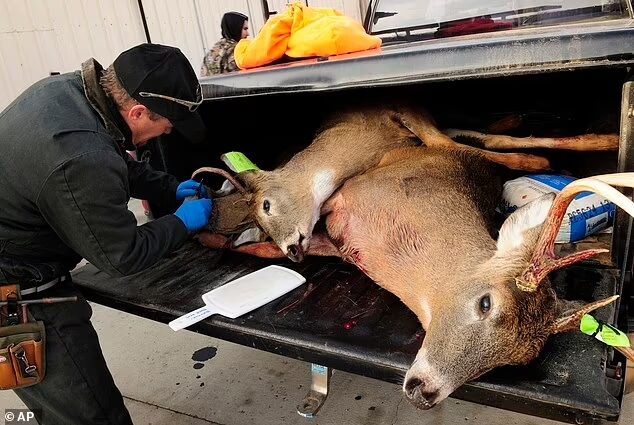
The fatal brain virus, which leaves animals confused, drooling, and unafraid of humans may someday infect people, as cautioned by some authorities.
The alarm was raised after a deer carcass tested positive for chronic wasting disease (CWD) in Yellowstone National Park in northwest Wyoming in November.
Dr. Cory Anderson told The Guardian: 'The BSE (mad cow) outbreak in Britain provided an example of how, overnight, things can get chaotic when a spillover event occurs, say, from livestock to people.'
In recent years, the virus spread to more than 31 US states, two Canadian provinces and even South Korea, according to the US Geological Survey.
'We're talking about the potential of something similar occurring,' said Anderson, the program co-director at the Center for Infectious Disease Research and Policy.
He added: 'No one is saying that it's definitely going to happen, but it's important for people to be prepared.'
According to Anderson, whose study focused on the pathways of CWD transmission, the disease is 'invariably fatal, incurable, and highly contagious,' he said.
'Baked into the worry is that we don't have an effective easy way to eradicate it, neither from the animals it infects nor the environment it contaminates.'
CWD is a prion-transmitted disease, similar to 'Mad Cow,' which can cause weight loss, loss of coordination and other eventually fatal neurological symptoms in deer and related species.
The US National Park Service said last month: 'There is currently no evidence that CWD can infect humans or domestic animal species.'
But the federal agency cautioned game hunters in particular, 'it is recommended that tissues from CWD-infected animals not be consumed.'
Samples from the body of the infected mule deer tested positive for CWD over multiple rounds conducted by the Wyoming Game and Fish Department's (WGFD) Wildlife Health Laboratory.
Typical testing of live and dead animals involves sampling a creature's nervous system tissue, either from the central nervous system, like the spinal cord, or peripheral systems, like the retropharyngeal lymph nodes and the tonsils.
Studies have proved that the disease posed a risk to non-human primates including monkeys, according to Centers for Disease Control and Prevention.
'These studies raise concerns that there may also be a risk to people,' the agency said. 'Since 1997, the World Health Organization has recommended that it is important to keep the agents of all known prion diseases from entering the human food chain.'
Park officials at Yellowstone said they are working with WGFD to monitor the park's deer and other hooved species, both dead and alive, to assess better how far CWD has spread through the national park.
Yellowstone National Park officials said that the discovery has prompted them to revise the park's 2021 CWD surveillance plan — with a new protocol version expected sometime next year.
Park spokesperson Morgan Warthin said Yellowstone also plans to increase its collaborative efforts with WGFD to identify which areas of the park are at increased risk from the disease.
CWD was first detected in mule deer in Wyoming in 1985 along the state's southeastern region.
The following year, the fatal brain disease was discovered in Wyoming elk, according to WGFD.
The disease's arrival in Yellowstone marks the end of a decades-long spread westward across the state, reaching the national park's location in Wyoming's northwest corner.
Wyoming game officials had been tracking the mule deer buck from March 2023 until October 2023, when its GPS tag indicated it had likely died.
Their search for its body took them to a landmass between the south and southeastern arms of Yellowstone Lake, known as the Promontory.
North of the park, Montana state wildlife regulators are also assisting in the effort and monitoring game caught by their state's local hunters.
A spokesperson for Region 3 of Montana Fish, Wildlife & Parks, Morgan Jacobsen, told the Daily Montanan that many CWD cases have not yet been detected in the state's hunting districts bordering Yellowstone.
Jacobsen described the news as a 'data point of interest,' but not one that would radically change Montana's own CWD surveillance plans.
'We're going to continue our monitoring and communication with the park and continue to work with hunters as the primary management tool for CWD in Montana,' Jacobsen said.



Comment: It's interesting that they've been talking about the possibility of CWD jumping to humans since at least 2017: Can Chronic Wasting Disease be transmitted from deer to humans?
See also: